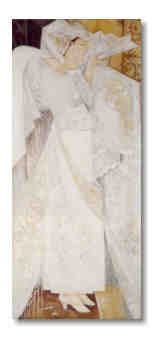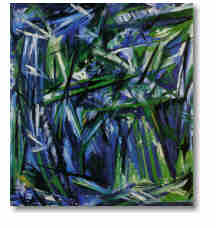


(1881-1962)
Goncharova's came from a well to do Russian family. She visited Paris in 1906, where she and her companion Mikhail Fedorovich Larionov examined the art of the Fauves and the proto-Cuhist work of Picasso. When she returned to Russia, she began to paint in a styles she had observed in Paris but soon thereafter she turned her attention to the Russian folk legacy and peasant art. Her interest in Futurism led her to collaborate with Larionov in the development of an abstract style they called "Rayonism." In 1915 she and Larionov settled permanently in Paris, where she turned her attention to stage design.
GONTCHAROVA'S THOUGHTS ON ART
"I am convinced that modern Russian art is
developing so rapidly and has reached such heights that within the near future it will be
playing a leading role in international life. Contemporary Western ideas (mainly of
France; it is not worth talking of the others) can no longer be of any use to us. And the
time is not far off when the West will be learning openly from us.
If we examine art from the artistic monuments we have at our disposal without bearing time
in mind, then I see It in this order: The Stone Age and the caveman's art are the dawn of
art. China, India, and Egypt with all their ups and downs in art have, generally speaking,
always had a high art and strong artistic traditions. Arts proceeding  from
this root are nevertheless independent: that of the Aztecs, Negroes, Austra-lian and
Asiatic islands-the Sunda (Borneo), Japan, etc. These, generally speaking, represent the
rise and flowering of art. Greece, beginning with the Cretan period (a transitional
state), with its archaic character and all its flowering, Italy right up to the age of the
Gothic, represent decadence. Gothic is a transitional state. Our age is a flowering of art
in a new form-a painterly form. And in this second flowering it is again the East that has
played a leading role. At the present time Moscow is the most important center of
painting. I shake off the dust of the West, and I consider all those people ridiculous and
backward who still imitate Western models in the hope of becoming pure painters and who
fear literariness more than death. Similarly, I find those people ridiculous who advocate
individuality and who assume there is some value in their "I" even when it is
extremely limited. Untalented individuality is as useless as bad imitation, let alone the
old-fashionedness of such an argument."
from
this root are nevertheless independent: that of the Aztecs, Negroes, Austra-lian and
Asiatic islands-the Sunda (Borneo), Japan, etc. These, generally speaking, represent the
rise and flowering of art. Greece, beginning with the Cretan period (a transitional
state), with its archaic character and all its flowering, Italy right up to the age of the
Gothic, represent decadence. Gothic is a transitional state. Our age is a flowering of art
in a new form-a painterly form. And in this second flowering it is again the East that has
played a leading role. At the present time Moscow is the most important center of
painting. I shake off the dust of the West, and I consider all those people ridiculous and
backward who still imitate Western models in the hope of becoming pure painters and who
fear literariness more than death. Similarly, I find those people ridiculous who advocate
individuality and who assume there is some value in their "I" even when it is
extremely limited. Untalented individuality is as useless as bad imitation, let alone the
old-fashionedness of such an argument."